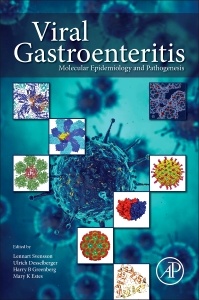Viral Gastroenteritis Molecular Epidemiology and Pathogenesis
Auteurs : Svensson Lennart, Desselberger Ulrich, Estes Mary K, Greenberg Harry B

Viral Gastroenteritis: Molecular Epidemiology and Pathogenesis provides a comprehensive review of research on viruses causing acute gastroenteritis in infants and young children, including coverage of rotaviruses, human caliciviruses, astroviruses, enteric adenoviruses, and viruses causing gastroenteritis more rarely. Includes general chapters on gastrointestinal physiology and pathophysiology, gastrointestinal immune mechanisms, immunodeficiencies and host genetics influencing susceptibility to viral gastroenteritis, and therapeutic and preventative approaches.
The book also includes special sections on virus particle structures, replication cycles, pathogenesis, immunology, epidemiology, and preventative measures. This book covers both basic science and translational applications and is an appropriate resource for virologists, molecular biologists, epidemiologists, gastroenterologists, vaccinologists, and those with an interest in public health.
Virologists, gastroenterologists, molecular biologists, immunologists, pathophysiologists, epidemiologists, vaccinologists, pediatricians and physicians (infectious diseases), and public health physicians
Ulrich Desselberger is a Professor in the Department of Medicine, of which he is the director, at the University of Cambridge whilst also actively consulting. He specialises in the molecular biology of rotaviruses.
Mary K Estes is the Professor of Virology and Microbiology at Baylor College of Medicine. Mary specialises in gastrointestinal viruses. Her academic career has seen her win many accolades including the Presidency of the American Society for Virology, and more recently the AGA Distinguished Achievement Award.
Harry B Greenberg is a Professor of the department of Microbiology and Immunology at the Stanford School of Medicine. On top of this position he also holds the Jospeh D Grant Professorship, is Director of Spectrum and the Senior Associate Dean for Research. Amongst his honors and awards, he has served as president of the American Society of Virology.
- Features new approaches in diagnosis and characterization of viral gastroenteritis pathogens
- Includes coverage of therapeutic and preventative methods
- Covers recent advances in characterizing the molecular biology and immune responses of rotaviruses and noroviruses
- Covers both basic science and translational applications and is an appropriate resource for virologists, molecular biologists, epidemiologists, gastroenterologists, vaccinologists, and those with an interest in public health
Date de parution : 07-2016
Ouvrage de 588 p.
15x22.8 cm
Thème de Viral Gastroenteritis :
Mots-clés :
animal astroviruses; animal models of infection; antiemetics; antimotility; antisecretory; astrovirus; attachment and postattachment interactions; calicivirus; caspases; cellular proteins; commensal bacteria; complement inhibition; complete genotypes; correlates of protection; diarrhea; diarrheal disease; diarrhoea; disease mechanisms; double-stranded RNA; electroneutral NaCl absorption; endocytosis; enteric nervous system; enteric virus pathogenesis; enteric viruses; epithelial barrier; epithelial permeability; ESCRT machinery; fluid balance; G type; gastroenteritis; gastrointestinal infection; genome organization; genome replication; Global Enteric Multicenter Study; glycans; glycosphingolipid; gnotobiotic pig; gut microbiota; HBGA; helper virus; histo-blood group antigens; IgG; immunity; intestinal absorption; intravenous rehydration; lipid droplets; lipid metabolism; live oral rotavirus; membrane remodelling; metagenomics; microbe-associated molecular patterns; microbiome; micronutrients; MLB; modular domain organization; molecular epidemiology; neonatal pig; next-generation sequencing; norovirus; NTA interactions; ondansetron; oral rehydration; oral tolerance; outbreaks; P type; particle structure; pathogen associated molecular patterns; pattern recognition receptors; poliovirus; polymeric Ig receptor; positive sense RNA virus; positive-sense RNA virus; primary immunodeficiency; probiotics; protein-protein interaction; reassortment; receptor; receptors and coreceptors; regulatory T cells; reverse genetics; Rhesus-human reassortant tetravalent; RNA polymerase; RNA transfection; Rotarix; RotaShield; rotavirus; rotavirus infection; rotavirus replication; rotavirus-specific SIg; rotavirus-specific T cells; rotavius-specific B cells; RV; secretor; secretory IgA; structure-function relationships; sugar transport; surveillance; transcription factors; transmission dynamics; VA



